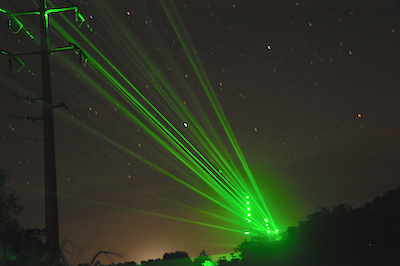Home
A comprehensive resource for safe and responsible laser use
US: Lasers create light fence to protect birds in Hawaii
18 Aug 2015 -- Categories: Unusual lasers & uses | SLA news
A power utility in Hawaii has finished a year-long test that used 30 lasers to help prevent birds from flying into power lines. The laser beams run parallel to the power lines and create a visible “light fence," which local birds then avoid. Initial results publicized in an August 17 2015 press release indicate the effort is successful. An expansion of the lasers and additional tests are planned.
According to the Kaua’i Island Utility Cooperative, “The lasers are similar to common laser pointers and use a narrowly focused green beam of light. Because the beams are parallel to the ground and because the installation is not in designated air space, the lasers do not pose a hazard to aircraft or passersby.”
According to the Kaua’i Island Utility Cooperative, “The lasers are similar to common laser pointers and use a narrowly focused green beam of light. Because the beams are parallel to the ground and because the installation is not in designated air space, the lasers do not pose a hazard to aircraft or passersby.”

Lasers create a “light fence” to illuminate transmission poles and power lines in ‘Ele‘ele, Kaua‘i in August 2014. Kaua‘i Island Utility Cooperative is again experimenting with lasers and other devices to reduce collisions between endangered seabirds and utility equipment during the season when the seabird colonies are most active. Photo credit: Shelley Paik, Kaua‘i Island Utility Cooperative
From a press release by the Kaua’i Island Utility Cooperative (reprinted below).
Lasers, Diverters Part of KIUC’s Expanded Seabird Protection Efforts
Līhu‘e, Kaua‘i, HI – 08/17/15 – Kauaʻi Island Utility Cooperative (KIUC) is continuing experimenting with highly concentrated beams of light from low powered lasers attached to transmission poles and the use of bird diverters on power lines as part of its ongoing effort to protect endangered seabirds.
“We are experimenting with the use of this technology as it could be a rapid and cost-effective way to reduce line strikes by endangered seabirds,” said Carey Koide, KIUC’s transmission and distribution manager, who also oversees its wildlife conservation efforts.
Last year, KIUC, in collaboration with the Kaua‘i Endangered Seabird Recovery Project (KESRP), created a “light fence” by attaching 30 lasers to transmission poles in ‘Ele‘ele. The seabirds fly in the dark because they only come to land after nightfall and the lasers create a visual “fence” in front of the power lines, allowing the birds to detect the lasers in the darkness and avoid the lines. Nighttime collisions are among the causes of death and injury to seabirds.
The lasers are similar to common laser pointers and use a narrowly focused green beam of light. Because the beams are parallel to the ground and because the installation is not in designated air space, the lasers do not pose a hazard to aircraft or passersby.
“This year, we have redesigned the laser controller module to provide us with more reliable on-off cycles and added wireless communications to each unit,” Koide said. “The lasers will be programmed to be on at alternating nights and biologists from KESRP will monitor the power lines during the test season.”
Lasers will be installed this month and testing will run through December.
“The initial testing of this redesigned unit at a Wedge-tailed Shearwater colony earlier this year yielded encouraging results, with shearwaters apparently avoiding the lasers the majority of the time,” said Marc Travers, Avian Conservation Biologist with KESRP. “This gives us hope that the endangered Newell’s shearwaters and Hawaiian petrels will see the lasers and thus avoid power lines in areas where we know collision is a problem.”
The new lasers will be again be tested on power lines in the ‘Ele‘ele coffee fields.
In addition to the lasers, KIUC is installing bird diverters, known as “Firefly” units. The devices hang from the power lines and have reflectors and glow in the dark features that make them visible to birds in low light conditions. The devices are being attached to spans of power lines along Kaumuali‘i Highway west of Hanapēpē and south of Kīlauea near the intersection of Kūhiō Highway and Ko‘olau Road.
These are some of the methods that the cooperative is exploring to reduce the risk of seabird collisions and is part of KIUC’s Habitat Conservation plan and incidental take permit.
Threatened native species including the Newell’s shearwater and the Hawaiian petrel are vulnerable to death or injury from collisions with utility equipment because they fly in and out to sea at night and in the early morning and are at greatest risk during a new moon phase when the skies are darkest.
The research is a collaboration between KIUC and KESRP, which is a State of Hawai‘i Department of Land and Natural Resources/Division of Forestry and Wildlife project, administered by the Pacific Studies Co-operative Unit of the University of Hawai‘i.
KIUC, in partnership with government agencies and conservation organizations, is the primary funding source for research into wildlife habitat protection on Kauaʻi. KIUC spends nearly $2 million a year to protect endangered wildlife, including research, power line and lighting reconfiguration, habitat restoration and predator control and injured bird rehabilitation. These experimental techniques, if effective, could drastically reduce the cost to KIUC and its members for protecting endangered seabirds.
###
Links to two high-resolution photos: 2014-0818-lasers05.jpg, 2014-0818-lasers30.jpg